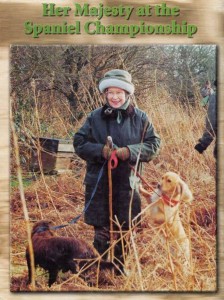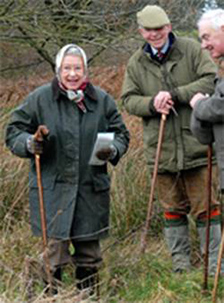Less Hacking Makes for a Better Field Experience
(adapted from Maine Sportsman article, September, 2002)
According to the dictionary, one meaning of “hack” is to “damage or injure by crude, harsh, or insensitive treatment,” and a “hacker” is a “person who engages in an activity without talent or skill.” In the dog world, “hacking” refers to those loud outbursts heard from handlers when their dog isn’t doing as expected. You’ve heard it — either from the mouths of hunting buddies or your own. Yelling disrupts the world around us, especially when we’re looking for that story book hunting experience: a beautiful fall day, the dog skillfully locating birds, straight shooting, and a full bird bag. On the other extreme, we could have a horror story: screaming over an increasingly unresponsive dog, birds flushing out of range, and time wasted waiting for a dog’s return.
When your dog gets out too far, do you start yelling, “Max, MAX!! *!%#!*! Get back here!”? By the third or fourth time you’ve said it he probably comes back, but now you’ve taught him he doesn’t have to come back until you get REALLY LOUD and say it three or four times. Let’s say you miss a bird; might have happened once or twice – probably bad ammo. What does the dog do? Does he give chase? What do you do? “No! No! *&%#@! Get back here! Max, MAX!!” By this time he’s flushed the bird again out of gun range and will return when he’s good and ready. Time and energy wasted.
If you are guilty of “hacking”, you can do something about it. The world and your gut will be a more peaceful place.
– Keep voice commands to single words, say them once, and never give one you aren’t willing to enforce. That may mean putting on your ogre face, going after the dog and bringing him back to the site of his sin.
– Don’t use the dog’s name when giving commands – only the command word.
– Use hand and whistle signals.
– Practice on yard drills using a long check cord.
– In the field, sometimes you must forget you’re a hunter when a few minutes training will serve you better.
– Save your loud voice for the most serious of sins.
The Working Vocabulary
Dogs can understand a small number of words. In our household, they retain the ones we want them to know, plus have a few others they’ve learned on their own. That’s why we go around spelling words such as O-U-T, and D-I-N-N-E-R. The working spaniel should learn the exact meaning of “Hup or Sit”, “Here”, or Come”. “No” and “Good” will also be words they understand. They should recognize their name, but it is NOT necessary to add their name to a command, “Max, come,” or “Hup, Buddy!” It confuses the dog. Say “Come”, or “Hup”.
The words in our dogs’ working vocabulary are: their names, “Hup”, “Here”, “Hold”, “Leave it”, “Heel”, “good”, “back”, “over”, “Kennel” (which means get in something – crate, car, or canoe), and that’s about it. The trick is to help them understand commands and obey them EVERY time. The easiest way to teach the words is to say them when the dog is performing that particular action.
What Is The Gun Dog Owner’s Most Valuable Tool?
You’re probably thinking shotgun right now, but if you are doing right by your dog and taking him to the field twelve months a year, your whistle accompanies you more often than your shotgun. We carry backup whistles in both vehicles just in case we forget to grab the one that hangs on the bedside lamp.
Dogs trained with the whistle respond to it well. We weak humans don’t ruin our whistle commands the way we do our words. The type of whistle is up to you, but the small elongated spaniel variety is just fine – it’s comfortable in the mouth — no pea – emits a high sound the dog can easily hear, but doesn’t blow out the ear drums. The dogs can hear the whistle at distances far beyond where we want them hunting — louder doesn’t mean better. Three whistle signals are all most dogs need: one firm pip means “Hup”, two short pips, “Turn and go the other direction”, and several rapid pips is the recall signal.
Teaching whistle commands is relatively simple. When the dog sits, say the word “Hup” and give one pip on the whistle. Every time you tell him to sit, give the pip. Soon he will sit on the whistle without the word. Do the same for recall. Attach the dog to a long check cord and have him sit. Walk away, face him, say, “Here,” and pull him in making the repeating pips on the whistle. Dogs respond positively to the whistle recall and that sound is preferable to a hollering human any day.
Most spaniels cut back instinctively, making it easy to teach the turn command. When they turn, give two pips simultaneously with the turn and eventually prior to it. The help of two friends walking out on both sides tempting the dog back and forth during the turning drill can help establish the best distance for you and your dog.
Using simple lessons in different combinations, you can teach and reinforce the verbal commands of “Hup”, “Here”, “Heel”, “Leave it”, and “Back” in the home whenever the opportunity presents itself – there are plenty. Use the whistle inside also when you can. Your dog will be more comfortable with the commands when you do outside yard work and eventually graduate to the field. It’s crucial the dog feels confident in training and always finishes on a positive note.
Now is the Time for Working Out Weaknesses
Upland bird season, hunt tests, and trials are never far away. It’s always time to take a hard look at yourself and your spaniel. Work out the wrinkles. Admit to weaknesses like hacking if you are guilty and focus on getting rid of them. A few minutes a day will pay off before you know it.



